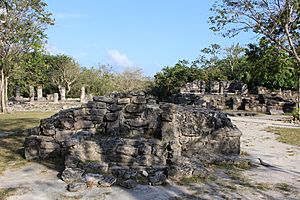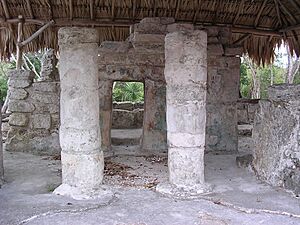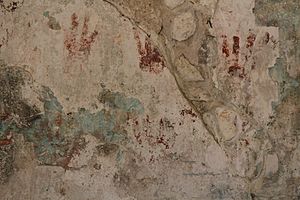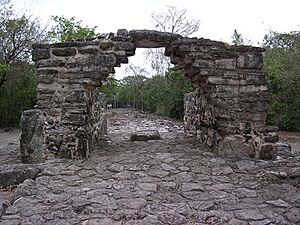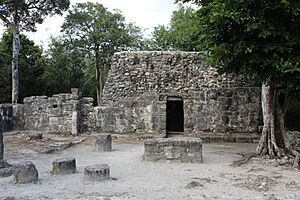San Gervasio (Maya site) facts for kids
| Location | San Miguel de Cozumel, Quintana Roo, |
|---|---|
| Region | Quintana Roo |
| Coordinates | 20°30′01″N 86°50′54″W / 20.500351°N 86.848297°W |
| History | |
| Founded | Early Classic |
| Abandoned | Between 1520 and 1600 |
| Periods | Early Classic to Colonial |
| Cultures | Maya civilization |
| Architecture | |
| Architectural styles | Mayapan and East Coast styles |
San Gervasio is an amazing archaeological site from the ancient Maya civilization. It is located on the island of Cozumel, off the coast of Mexico. The Maya people called this place Tantun Cuzamil, which means Flat Rock in the place of the Swallows.
San Gervasio was a very important place for worshipping the goddess Ix Chel. She was a powerful Maya goddess of childbirth, healing, and weaving. Maya women would travel here to make offerings to her at least once in their lives. It was like a holy pilgrimage site for them.
In the 1500s, Spanish historians wrote about how important Cozumel was to the Maya. They said people visited to make offerings and ask for help from their gods. One bishop even compared it to how people today visit holy places like Jerusalem or Rome.
Contents
Exploring San Gervasio Today
Many of the stone buildings at San Gervasio no longer have their roofs. But in the 1970s, archaeologists carefully studied the ruins. They made detailed maps and drawings to show how the buildings once looked. You can see pictures of these reconstructed buildings in guidebooks.
The area around the ruins is a special wildlife refuge. You might see many iguanas here; they are used to people! Other lizards, peccaries (wild pigs), and coatis (like raccoons) also live here. They usually keep their distance from visitors.
The San Gervasio site is very large, covering several square kilometers. However, only a small part of it is open for visitors to explore. Most of the accessible buildings are found near the main plaza area.
A Look Back at San Gervasio's History
The first Europeans to arrive at Cozumel and San Gervasio were led by Juan de Grijalva in 1518. Another group came with Hernán Cortés in 1519. The Maya people of Cozumel welcomed both groups. Cortés even wrote a letter saying the island had no gold and its people were peaceful.
Sadly, this letter did not help much when another Spanish group arrived in 1520. Some of their crew members were sick with smallpox. This disease spread quickly across the island. Archaeologists have found three mass graves at San Gervasio where smallpox victims were buried. They were found with glass beads given to them by the Spanish.
Amazing Buildings at San Gervasio
Las Manitas: The Little Hands House
- Meaning: Little Hands
- Built: Around 1000-1200 AD
- Location: East of the main plaza
Las Manitas was once the home of the halach unik, who was the Maya ruler of Cozumel. It has an outer room where he lived and a secret inner room that was his personal shrine. The building gets its name from red handprints found on the inside walls.
Chi Chan Nah: The Small House
- Meaning: Small House
- Built: After 1200 AD
- Location: East of Las Manitas
This building was a small chapel or prayer room. The family of the ruler who lived in Las Manitas used it. It had a large outer room and a small inner room with an altar. Near this building, a unique tomb was found in 1973. It was the only one of its kind at San Gervasio.
Ka'na Nah: The Tall House
- Meaning: Tall House
- Built: Around 1200-1650 AD
- Location: West of the main plaza
This pyramid is the biggest building at San Gervasio. It might have been the main temple for the goddess Ix Chel. Spanish writers in the 1500s described a temple here with a hollow idol. A priest could hide inside the idol and speak to people, making them believe the god was talking to them. People would offer birds, dogs, their own blood, and even men to this statue.
El Arco: The Archway Entrance
- Meaning: The Arch
- Built: Reconstructed in the 1980s
- Location: Northeast of the main plaza
This arch is the main entrance to the central plaza area from the north and west. It is about seven feet tall. It stands over a special religious pathway called a sacbe, which means "white road" in Maya. This arch was rebuilt to look like similar arches found at other Maya sites in the area.
North of the arch, you can find small holes in the ground. These are natural sinkholes called cenotes (from the Maya word d'zonot). They were important sources of water for the people living at San Gervasio.
District 1 Central Plaza: The Heart of the Site
- Built: Around 1200-1650 AD
- Location: Northwest of the entrance
The Central Plaza has six buildings arranged around a central altar. Some of these buildings once had roofs made of wood and thatch, which have since disappeared. Others had roofs made of wood beams and mortar. A few even had rooms with special arched ceilings. All these buildings were public spaces, including temples, chapels, altars, and a building for visitors who came for religious events.
Nohoch Nah: The Big House
- Meaning: Big House
- Built: Around 1000-1650 AD
- Location: North of the main plaza
This building is one of the best-preserved at San Gervasio because its roof is still intact. Inside, you can see faint signs of a red, ochre, and blue mural on the walls. This building was a temple dedicated to Ku’kul’kan, the feathered serpent god.
Los Murcielagos: The Bats' Home
- Meaning: The Bats
- Built: Around 600-1000 AD
- Location: Northwest of the main plaza
This area has several rooms and smaller buildings on a platform. It was the home of the Maya ruler of Cozumel during a later period of the Maya civilization.
Images for kids
See also
 In Spanish: Cozumel (zona arqueológica) para niños
In Spanish: Cozumel (zona arqueológica) para niños


